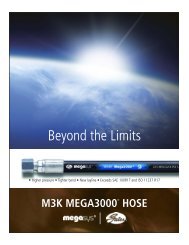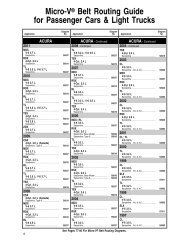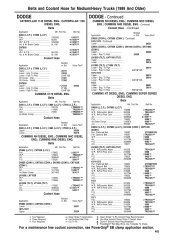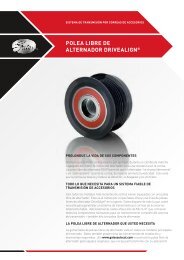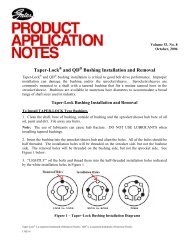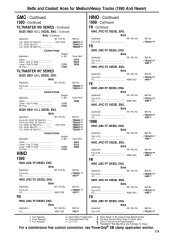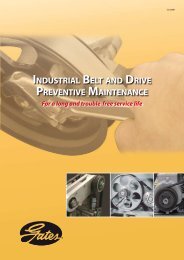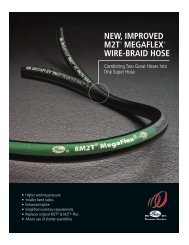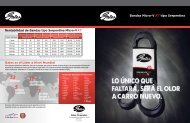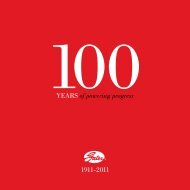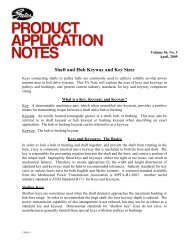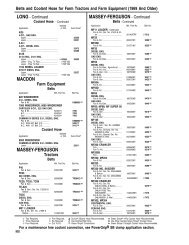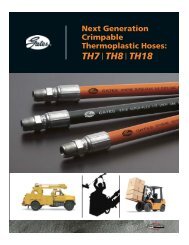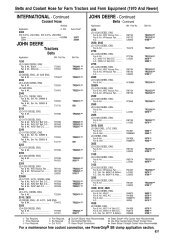oil field maintenance manual - Gates Corporation
oil field maintenance manual - Gates Corporation
oil field maintenance manual - Gates Corporation
You also want an ePaper? Increase the reach of your titles
YUMPU automatically turns print PDFs into web optimized ePapers that Google loves.
OIL FIELD MAINTENANCE MANUAL<br />
33498-M<br />
May 2008
OFFSHORE<br />
LAND RIG<br />
Safety & Maintenance of <strong>Gates</strong> Rotary & Vibrator Hoses<br />
Forward<br />
The objective of this <strong>manual</strong> is to emphasize SAFETY by providing recommended<br />
procedures for proper handling, storage, use and <strong>maintenance</strong> of rotary drilling and<br />
vibrator hose assemblies. External inspection and <strong>field</strong> pressure testing prior to any<br />
continued service of a hose assembly is critical to ensure safe operation. These are<br />
MANDATORY PROCEDURES for applications where an assembly failure could<br />
result in serious bodily injury or severe property damage.<br />
Scope<br />
This procedure is a recommended<br />
practice for the storage, handling,<br />
operations, testing and inspection of<br />
flexible connectors.<br />
This includes connectors between the<br />
standpipe and swivel (A: Rotary Drilling<br />
Hose) as well as connectors between the<br />
pump and standpipe (B: Vibrator Hose)<br />
for pumping mud at high pressures<br />
during <strong>oil</strong> drilling and exploration work<br />
(see Figure 1).<br />
This applies to hoses having inside<br />
diameters of up to 4” with API grade<br />
classifications D and E.<br />
Warning<br />
A failure of a rotary drilling or<br />
vibrator hose in service may result in<br />
serious bodily injury or severe<br />
property damage.<br />
NOTE: All large land and offshore rigs<br />
have many other components, but basic<br />
usage of rotary and vibrator hose shown<br />
here is virtually the same on all of them.<br />
Page 1
OFFSHORE<br />
LAND RIG<br />
Safety & Maintenance of <strong>Gates</strong> Rotary & Vibrator Hoses<br />
Storage<br />
1. Completely drain hose assembly before<br />
placing in storage.<br />
2. Whenever feasible, store hose in original<br />
shipping crate. This will provide extra<br />
protection against the deteriorating effects<br />
of solvents, corrosive liquids, ozone and<br />
sunlight. Hose should be stored so c<strong>oil</strong>s<br />
are in a horizontal plane.<br />
3. Certain rodents and insects can damage<br />
hose. Adequate protection from them<br />
should be provided too.<br />
4. The ideal temperature for storing hose<br />
ranges from 50 o F (10 o C) to 70 o F (21 o C)<br />
with a maximum limit of 100 o F (38 o C). If<br />
stored below 32 o F (0 o C), hose will<br />
become stiff and will require warming<br />
before being placed in service. Hose<br />
should not be stored near sources of heat,<br />
such as radiators or base heaters.<br />
5. To avoid adverse affects of high ozone<br />
concentrations, hose should not be stored<br />
near electrical equipment that may<br />
generate ozone or be stored for any<br />
lengthy period in geographical areas with<br />
high concentrations of ozone. Exposure to<br />
sunlight, direct, reflected or even through<br />
windows should be avoided.<br />
Handling<br />
Caution: Care should be exercised to<br />
prevent mishandling. Crushing or kinking<br />
of hose can cause severe damage to<br />
reinforcement. If this occurs, remove<br />
hose from service.<br />
1. In order to minimize the chance of<br />
kinking, hose should preferably be<br />
removed from its crate by hand, laid out<br />
in a straight line, then lifted by means<br />
of a catline attached near one end of<br />
hose.<br />
2. Hose assemblies should never be lifted<br />
by the safety clamp and chain. The<br />
assembly should always be lifted by<br />
the lift eye clamps (see figures 2 and 5).<br />
3. Attachment of a set of lift eye clamps<br />
to the hose end coupling to safely lift and<br />
move a heavy rotary hose assembly is a<br />
necessity to avoid hose kink damage.<br />
A set of lift eye clamps can be obtained<br />
on special order (see Figure 2).<br />
6. Do not stack hose or place anything<br />
heavy on top of it to prevent damage.<br />
Page 2
OFFSHORE<br />
LAND RIG<br />
Safety & Maintenance of <strong>Gates</strong> Rotary & Vibrator Hoses<br />
Recommended Practices<br />
Where applicable, the following<br />
recommended practices should be used<br />
on rotary drilling and vibrator hose.<br />
A. Overall Hose Length<br />
1. Includes standard connector and/or<br />
special adapters (see Figure 3).<br />
B. Rotary Hose Length<br />
1. In order to avoid kinking hose, the<br />
hose length and standpipe height<br />
should be such that when raising or<br />
lowering, as in making mousehole<br />
connections, the hose will have a<br />
normal bend radius at the swivel<br />
when it is at its lowest drilling<br />
position and at the standpipe when it<br />
is at its highest drilling position. Use<br />
the following equation to determine<br />
the recommended hose length.<br />
L H = L T /2 + π R + S<br />
Where:<br />
L H = Length of hose in ft.<br />
L T = Length of hose travel in ft.<br />
R = Minimum bend radius in ft.<br />
= 4’ for 2 1/2” and 3” hose<br />
= 4.5’ for 3 1/2” and 4” hose<br />
S = Allowance for contraction in L H<br />
due to maximum recommended working<br />
pressure in ft., which is 1 ft. for all sizes.<br />
Page 3<br />
C. Standpipe Height<br />
1. Use the following equation to<br />
determine the recommended<br />
standpipe height (see Figure 4).<br />
H S LT/2 + Z<br />
Where:<br />
H S = Vertical height of standpipe in ft.<br />
L T = Length of hose travel in ft.<br />
Z = Height in ft. from top of derrick<br />
floor to end of hose at swivel when<br />
swivel is at its lowest drilling position.<br />
NOTE: When the actual hose length is<br />
greater than the calculated length, the<br />
standpipe height should be increased by<br />
half the difference between the actual<br />
length and calculated height.
OFFSHORE<br />
LAND RIG<br />
Safety & Maintenance of <strong>Gates</strong> Rotary & Vibrator Hoses<br />
D. Vibrator Hose Length<br />
1. It’s important to choose a vibrator hose<br />
having an inside diameter equal to that<br />
of the pump discharge fitting and the<br />
fluid supply line inside diameters. This is<br />
necessary to allow free flow of fluid and<br />
to avoid turbulence or unnecessary<br />
abrasion of the hose tube. The length of<br />
vibrator hose should be given careful<br />
consideration. It should be long enough<br />
to prevent kinks near the couplings, yet<br />
short enough to prevent kinks in the<br />
radius near the middle of the hose.<br />
E. Hose Connections<br />
1. Line pipe threads should only be used<br />
on working pressure of 5,000 psi or less.<br />
Threaded end connections should not<br />
be welded to the coupling as this will<br />
damage hose. Working pressure of<br />
5,000 psi and above should have end<br />
connections butt welded to the coupling.<br />
The connections attaching the hose to<br />
the swivel and standpipe should be as<br />
tangential as possible. The use of a<br />
standard connection on the swivel<br />
gooseneck will ensure this relationship<br />
at top of hose. It’s recommended that a<br />
180 degree gooseneck be used on the<br />
standpipe connection if the standpipe is<br />
vertical. A 160 degree gooseneck<br />
should be used if the standpipe has the<br />
same slope as the derrick leg.<br />
F. Vibration and Pulsation<br />
1. Continuous pressure pulsations and<br />
vibrations may shorten the useful life of<br />
rotary and vibrator hoses used in high<br />
pressure mud piping systems. Surge<br />
chambers or pulsation dampeners of<br />
the proper size should be installed in<br />
each mud pump discharge line to<br />
minimize pulsations and vibrations in<br />
the mud lines and hoses. The<br />
pre-charge pressure for pulsation<br />
dampeners should be set at 10 percent<br />
of the maximum pump pressure. The<br />
lines on the suction side of the pump<br />
should be pressure charged or operated<br />
with a flooded suction to minimize<br />
cavitations that can cause pulsations.<br />
Pulsation dampeners designed for the<br />
pump suction lines should also be<br />
installed to minimize pulsation if<br />
cavitations occur.<br />
G. Operating Limits.<br />
1. Operating personnel should be advised<br />
as to the highest and lowest drilling<br />
positions, length of standpipe, etc., for<br />
which the hose was selected. Drilling<br />
operations should be carried out within<br />
such limits.<br />
H. Clearance<br />
1. Hose installation should allow adequate<br />
clearance between hose and derrick or<br />
mast.<br />
I. Barge Attended Off-Shore Rigs<br />
1. When rotary hose is used as a flexible<br />
line between barges or off-shore drilling<br />
rigs, care must be used so hose is in<br />
alignment between both end<br />
connections. It’s recommended that<br />
swivel joints be used at both ends.<br />
Drilling in rough water and high seas,<br />
resulting in excessive flexing and<br />
jerking of hose, will cause premature<br />
failure.<br />
Page 4
OFFSHORE<br />
LAND RIG<br />
Safety & Maintenance of <strong>Gates</strong> Rotary & Vibrator Hoses<br />
Operations<br />
Caution: Care should be exercised<br />
during operation to prevent crushing or<br />
kinking of hose. Crushing or kinking can<br />
cause severe damage to cable<br />
reinforcement. If this occurs, remove<br />
hose from service and test as outlined in<br />
the “Field Test Pressure” section.<br />
D. Oil Base Muds<br />
1. The use of <strong>oil</strong> base muds having an<br />
excessively high aromatic content<br />
will cause hose inner liner to swell,<br />
resulting in less abrasion resistance<br />
which can shorten service life. It’s<br />
recommended that <strong>oil</strong> base muds<br />
be held to a minimum aniline point<br />
of 150°F (66°C).<br />
A. Working Temperature<br />
1. Working temperature should not<br />
exceed 180°F (82°C).<br />
Temperatures encountered higher<br />
than 180°F (82°C) will shorten<br />
the useful life of the hose.<br />
B. After Coolers<br />
1. Compressors should always be<br />
equipped with after coolers to lower<br />
the air or gas temperatures within<br />
tolerable limits. If after coolers are<br />
not used, air or gas entering hose at<br />
excessively high temperatures can<br />
accelerate the hose aging rate, thus<br />
reducing the expected service life.<br />
C. Working Pressure<br />
1. The recommended maximum<br />
working pressure for rotary hose is<br />
shown in Table 1. Working pressure<br />
includes the pressure surges that<br />
occur in the system.<br />
Page 5<br />
E. Twisting<br />
1. Hose should not be intentionally<br />
back twisted. In order to prevent<br />
twisting, it’s suggested that a swivel<br />
be installed on the gooseneck end<br />
of hose. Each length of hose has a<br />
yellow longitudinal stripe. Use this<br />
as a guide to ensure hose is<br />
installed without any twist.<br />
F. Safety Clamps (see Figure 5)<br />
1. All rotary hoses and vibrator hoses<br />
8’ or longer are marked with the<br />
notation “Attach Safety Clamp Here”.<br />
Safety clamps must be installed prior<br />
to placing hose into service.<br />
a. For rotary hose — This dimension<br />
shall be 6” to 18” from the inboard<br />
end of the coupling.<br />
b. For vibrator hose — This<br />
dimension shall be 6” to 10” from<br />
the inboard end of the coupling.<br />
2. A set of safety clamps can be<br />
obtained on special order. The<br />
location for attaching these safety<br />
clamps is shown by marks at each<br />
end of the assembly. Lift eye/clamps<br />
are also available. Do not use the<br />
safety clamp or chain for lifting (see<br />
Figure 5).
OFFSHORE<br />
LAND RIG<br />
Safety & Maintenance of <strong>Gates</strong> Rotary & Vibrator Hoses<br />
Operations Cont.<br />
3. The safety clamp should be<br />
tightened securely, but not to such<br />
an extent as to damage hose or<br />
reduce the inside bore diameter. In<br />
the case of rotary hose, the safety<br />
chain should be attached to a derrick<br />
upright at the standpipe end, rather<br />
than a transverse support, so the<br />
chain will be free to move upward<br />
without restricting movement of the<br />
hose, should the traveling block be<br />
raised too high.<br />
2. Avoid all back twist.<br />
3. Suspend hose in normal unstressed<br />
position from standpipe to swivel.<br />
4. Visually inspect hose for any<br />
external damage to hose body, end<br />
structure or couplings.<br />
5. Raise pressure between 1,000 and<br />
10,000 psi per minute.<br />
6. Bleed air when using mud, <strong>oil</strong> or<br />
water as permissible test media.<br />
7. Restrict duration of test pressure<br />
to a maximum of 10 minutes.<br />
8. Do not exceed 1.25 times the<br />
maximum rated working pressure<br />
when testing.<br />
Field Test Pressure<br />
Hose assemblies subjected to abnormal<br />
abuse such as severe end pull, flattening,<br />
crushing, sharp kinking or excessive<br />
pressurization must be immediately<br />
inspected and hydro-statically tested at<br />
1.25 times the rated working pressure.<br />
Follow steps 4 through 9 below.<br />
Field testing of rotary hose, when<br />
required for establishing periodic safety<br />
levels of continued operation, should be<br />
conducted with these factors as a guide:<br />
1. Check and properly attach safety<br />
clamp and chain for complete safety<br />
compliance.<br />
Page 6<br />
9. Conduct <strong>field</strong> testing under full<br />
responsibility of end user with<br />
SAFETY in mind.<br />
External Inspection<br />
1. Carefully examine hose cover prior to<br />
each rig-up or every 30 days,<br />
whichever comes first.<br />
2. Hose cover serves the primary<br />
function of protecting cable<br />
reinforcement from physical or<br />
environmental damage. Cover<br />
should be carefully examined to<br />
detect areas where cable<br />
reinforcement may have been<br />
damaged. Inspect hose cover for<br />
cuts, gouges, tears and abrasion.<br />
3. Any cuts, gouges or tears in the<br />
cover down to, but not into cable<br />
reinforcement should be regularly
OFFSHORE<br />
LAND RIG<br />
Safety & Maintenance of <strong>Gates</strong> Rotary & Vibrator Hoses<br />
External Inspection Cont.<br />
inspected to ensure further<br />
deterioration does not occur. If<br />
cable reinforcement is exposed<br />
and rust or corrosion is evident,<br />
remove hose from service.<br />
4. Cover may show surface cracking<br />
due to prolonged exposure to<br />
sunlight or ozone. Such<br />
deterioration, as long as it does<br />
not expose the cable<br />
reinforcement, is not usually<br />
cause for removal from service.<br />
On-The-Job Welding<br />
CAUTION: On-the-job welding of hose<br />
assemblies is not recommended.<br />
Excessive heating from welding can<br />
cause hose damage.<br />
Warranty<br />
Black Gold ® <strong>oil</strong> <strong>field</strong> hoses are warranted<br />
by <strong>Gates</strong> <strong>Corporation</strong> to be free from<br />
defects in material and workmanship for<br />
the life of the product. Should a defect be<br />
proven in the product’s material or<br />
workmanship, <strong>Gates</strong> will, at its option,<br />
replace or repair any rotary drilling or<br />
vibrator hose of our manufacture.<br />
Page 7
OFFSHORE<br />
LAND RIG<br />
GATES CERTIFIED ROUGHNECK DISTRIBUTORS<br />
<strong>Gates</strong> Rotary Drilling, Vibrator, Cementing, Sour Service, Choke and Kill, Motion Compensator and De-coker <strong>oil</strong><strong>field</strong><br />
hoses shown in this section have couplings attached by a <strong>Gates</strong> certified assembler from hose already in their stock.<br />
The advantage is that hose from the assembler’s stock can be cut to the customer’s specified length. Couplings are<br />
then swaged-on, tested to API 7K standards and then shipped all in a matter of just hours! This greatly reduces the<br />
Lead time required to supply product meeting customer specific needs. The resulting hose assembly far exceeds<br />
<strong>Gates</strong> standard for coupling pull and burst pressure tests assuring <strong>Gates</strong> high quality for added safety.<br />
Du-Tex, Inc.<br />
134 44th Street<br />
Corpus Christi, Texas 78405<br />
www.dutex.com<br />
Ph. 361-887-9807<br />
FAX: 361-887-0812<br />
Mike Ray, Vice President<br />
dutex@msn.com<br />
Robsco, Inc.<br />
4749 Eastpark Drive<br />
Houston, Texas 77028<br />
www.robsco.com<br />
Ph. 713-672-1777<br />
FAX: 713-672-1956<br />
Kenneth Jones<br />
ken@robsco.com<br />
Frank Navarro<br />
frank@robsco.com<br />
4-Star Hose & Supply<br />
610 W. Industrial Boulevard<br />
Cleburne, TX 76033<br />
www.4starhose.com<br />
Ph. 866-427-0707<br />
FAX: 817-645-4424<br />
Robert Adair<br />
radair@4starhose.com<br />
Kevin Brown<br />
Kbrown@4starhose.com<br />
Charles Hudgens<br />
chudgens@4starhose.com<br />
<strong>Gates</strong> A.E. Hydraulics Pte Ltd<br />
40 Gul Circle<br />
Jurong Industrial Estate<br />
Singapore 629575<br />
www.aehydraulic.com<br />
Ph. (65) 6861 7322<br />
Fax: (65) 6861 7631<br />
YK Chua, Sales Director<br />
ykchua@aehydraulic.com<br />
<strong>Gates</strong> Fleximak Ltd.<br />
Mod. 215 731b Street<br />
P.O. Box 61046<br />
Jebel Ali<br />
Dubai<br />
United Arab Emirates<br />
www.gatesfleximak.com<br />
Ph. 971 4 8813900<br />
FAX: 971 4 8813902<br />
Kim Henderson / Tony Rogowsky<br />
info@gatesfleximak.com<br />
<strong>Gates</strong> Lerma<br />
Air Springs de Mexico S.A. de C.V.<br />
Blvd. Aeropuerto Miguel Aleman No. 164<br />
Lerma, Mexico<br />
C.P. 50200<br />
www.gates.com.mx<br />
Ph. (01-55) 5333-2777<br />
FAX: (01-55) 5333-2727<br />
Antonio Santibanez O.<br />
AS1108@gates.com<br />
GS Hydro Norge A/S<br />
Stavanger Branch<br />
Fabrikkveien 26<br />
4033 Stavanger<br />
Norway<br />
www.gshydro.com<br />
Ph. (47) 51 95 96 40<br />
FAX: (47) 51 95 96 41<br />
Espen Myhre, Sales & Project Coordinator<br />
espen.myhre@gshydro.no<br />
Hydrasun Limited<br />
392 King Street<br />
Aberdeen AB24 3BU<br />
United Kingdom<br />
www.hydrasun.com<br />
Ph. 44 (0) 1224 618618<br />
FAX: 44 (0) 1224 618612<br />
Bill Anderson, Special Projects Manager<br />
bill.anderson@hydrasun.com<br />
Page 8
OFFSHORE<br />
LAND RIG<br />
<strong>Gates</strong> Worldwide Locations<br />
<strong>Gates</strong> <strong>Corporation</strong><br />
1551 Wewatta Street, P.O. Box 5887<br />
Denver, Colorado 80217-5887<br />
Tel: (303) 744-5070<br />
Fax: (303) 744-4540<br />
<strong>Gates</strong> Canada, Inc.<br />
300 Henry Street<br />
Brantford, Ontario<br />
N3S 7R5, Canada<br />
Tel: (519) 759-4141<br />
Fax: (519) 759-0944<br />
<strong>Gates</strong> Rubber de Mexico<br />
Cerrada de Galeana No. 5<br />
Fracc. Industrial La Loma<br />
54060 Tlalnepantla<br />
Edo de Mexico, Mexico<br />
Tel: 52-555-333-2700<br />
Fax: 52-555-333-2701<br />
<strong>Gates</strong> Europe N.V.<br />
Dr, Carlierlaan 30<br />
B-9320 Erembodegem, Aalst<br />
Belgium<br />
Tel: 32-53-762-711<br />
Fax: 32-53-762-713<br />
<strong>Gates</strong> <strong>Corporation</strong><br />
Latin America Operations<br />
<strong>Gates</strong> InterAmerica<br />
3609 North 29th Avenue<br />
Hollywood, Florida 33020 USA<br />
Tel: (954) 926-4568<br />
Fax: (954) 926-8024<br />
<strong>Gates</strong> Argentina<br />
Irala 345<br />
(1163) Buenos Aires<br />
Argentina<br />
Tel: 54-11-4307-5050<br />
Fax: 54-11-4307-3907<br />
<strong>Gates</strong> do Brasil Ind. & Com. Ltda.<br />
Rua Cesario Alvim, 624<br />
Caixa Postal, 1521<br />
03054-900 Sao Paulo<br />
Brasil<br />
Tel: 55-11-609-98822<br />
Fax: 55-11-291-0647<br />
<strong>Gates</strong> Rubber Co. (S) Pte. Ltd.<br />
No. 1 Changi South Street 3<br />
Singapore 486477<br />
Tel: 65-545-3800<br />
Fax: 65-545-5322<br />
The <strong>Gates</strong> Group (Shanghai) Co., Ltd.<br />
No. 15 Hai Tang Street<br />
China-Singapore Suzhou Industrial Park<br />
Suzhou 215021<br />
PR China<br />
Tel: 86-521-6761-9633<br />
Fax: 86-512-6761-7184<br />
<strong>Gates</strong> Indonesia (Representative Office)<br />
Ariobimo Sentral 4 th Floor<br />
JI. H.R. Rasuna Said Kav.X-2<br />
No. 5, Jakarta 12950, Indonesia<br />
Tel: 62-21-5270-721<br />
Fax: 62-21-2525-760<br />
<strong>Gates</strong> Rubber Company<br />
Mastura Building 5/F<br />
1-9-6 Shiba, Minato-ku<br />
Tokyo, 105-0014, Japan<br />
Tel: 81-3-5439-5188<br />
Fax: 81-3-5439-5189<br />
<strong>Gates</strong> Thailand (Representative Office)<br />
Eastern Seaboard Industrial Estate<br />
64/86 Moo4 T. Pluakdang A. Pluakdang<br />
Rayang 21140, Thailand<br />
Tel: 66-38-954-361<br />
Fax: 66-38-954-362<br />
<strong>Gates</strong> India<br />
Ambala Chandigarh Highway<br />
P.O: Lairu, 140501<br />
Punjab, India<br />
Tel: 91-1762-27050-53<br />
Fax: 91-1762-274151<br />
<strong>Gates</strong> Australia Pty. Ltd.<br />
1-15 Hydrive Close<br />
Dandenong South, Victoria 3175<br />
Australia<br />
Tel: 61-3-9797-9666<br />
Fax: 61-3-9797-9600<br />
Page 9
MAY 2008<br />
33498-M<br />
The World’s Most Trusted Name<br />
in Belts, Hose and Hydraulics.<br />
<strong>Gates</strong> <strong>Corporation</strong><br />
P.O. Box 5887<br />
Denver, CO 80217-5887<br />
800-777-6363<br />
www.gates.com<br />
©2008 <strong>Gates</strong> <strong>Corporation</strong> Printed in U.S.A. 33498-M 5/08



